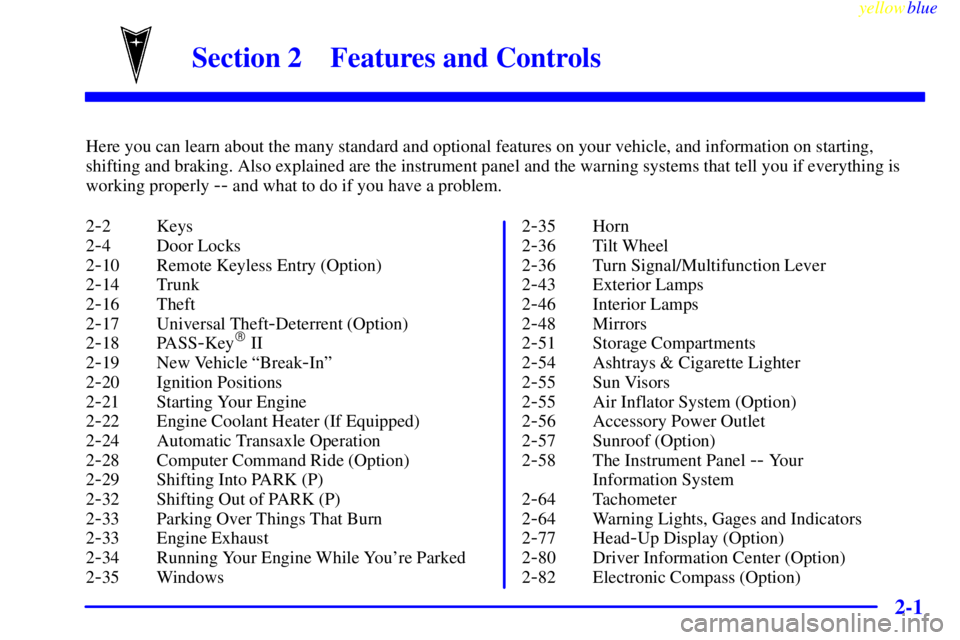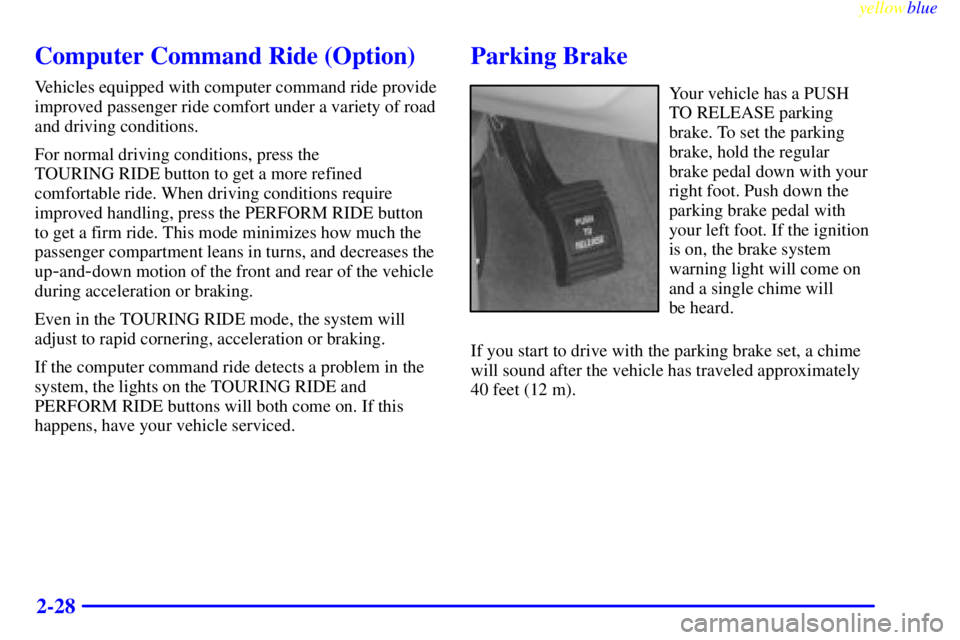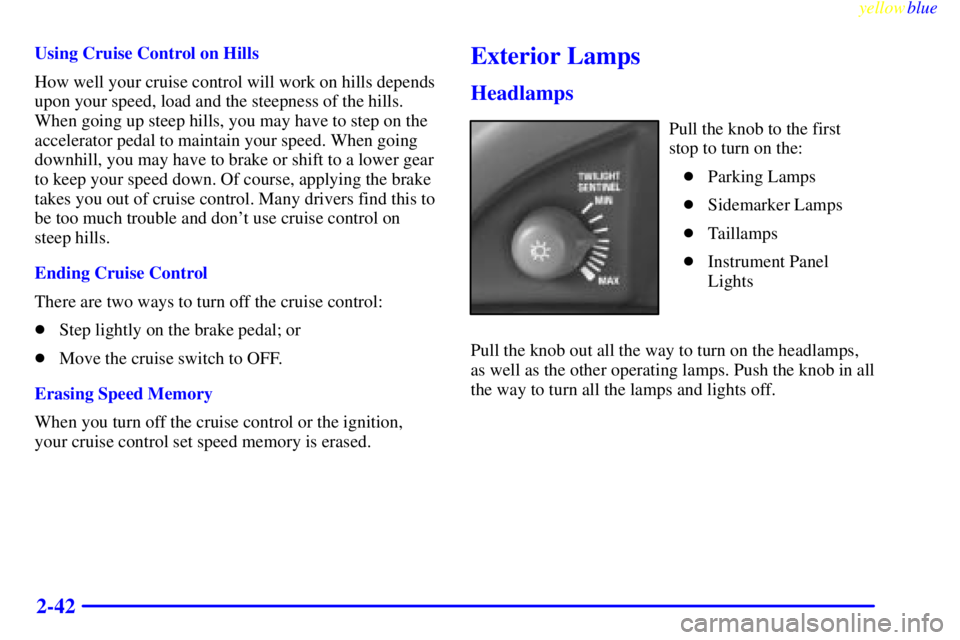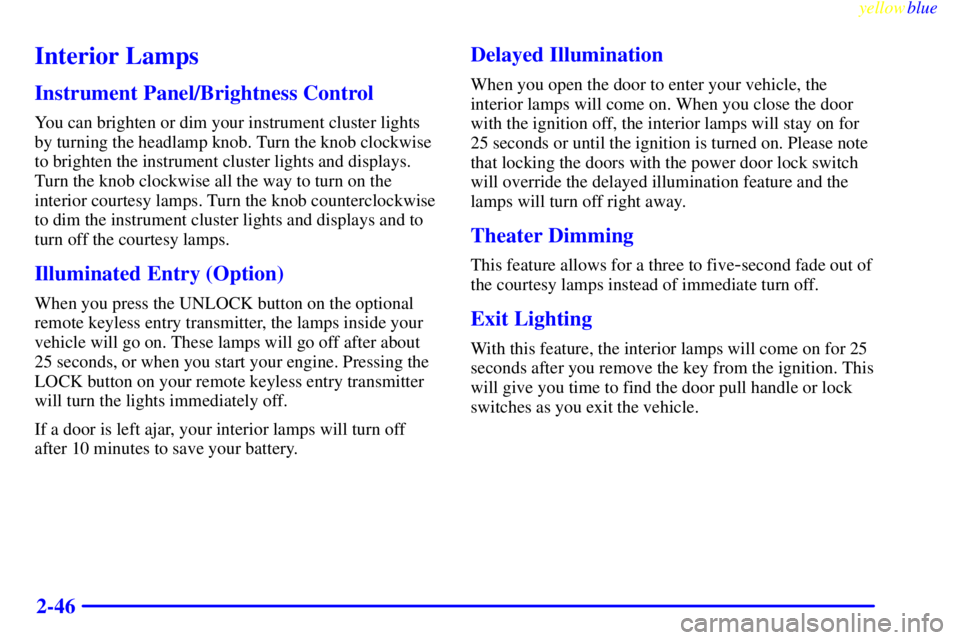Page 5 of 392

First Edition for Pontiac Bonneville Owner's Manual ± 1999
yellowblue
v
For example,
these symbols
are used on an
original battery:
CAUTION
POSSIBLE
INJURY
PROTECT
EYES BY
SHIELDING
CAUSTIC
BATTERY
ACID COULD
CAUSE
BURNS
AVOID
SPARKS OR
FLAMES
SPARK OR
FLAME
COULD
EXPLODE
BATTERY
These symbols
are important
for you and
your passengers
whenever your
vehicle is
driven:
DOOR LOCK
UNLOCK
FASTEN
SEAT
BELTS
POWER
WINDOW
AIR BAG
These symbols
have to do with
your lamps:
MASTER
LIGHTING
SWITCH
TURN
SIGNALS
PARKING
LAMPS
HAZARD
WARNING
FLASHER
DAYTIME
RUNNING
LAMPS
FOG LAMPS
These symbols
are on some of
your controls:
WINDSHIELD
WIPER
WINDSHIELD
WASHER
WINDSHIELD
DEFROSTER
REAR
WINDOW
DEFOGGER
VENTILATING
FAN
These symbols
are used on
warning and
indicator lights:
ENGINE
COOLANT
TEMP
BATTERY
CHARGING
SYSTEM
BRAKE
COOLANT
ENGINE OIL
PRESSURE
ANTI-LOCK
BRAKES
Here are some
other symbols
you may see:
FUSE
LIGHTER
HORN
SPEAKER
FUEL
Vehicle Symbols
These are some of the symbols you may find on your vehicle.
Page 61 of 392

2-
yellowblue
2-1
Section 2 Features and Controls
Here you can learn about the many standard and optional features on your vehicle, and information on starting,
shifting and braking. Also explained are the instrument panel and the warning systems that tell you if everything is
working properly
-- and what to do if you have a problem.
2
-2 Keys
2
-4 Door Locks
2
-10 Remote Keyless Entry (Option)
2
-14 Trunk
2
-16 Theft
2
-17 Universal Theft-Deterrent (Option)
2
-18 PASS-Key� II
2
-19 New Vehicle ªBreak-Inº
2
-20 Ignition Positions
2
-21 Starting Your Engine
2
-22 Engine Coolant Heater (If Equipped)
2
-24 Automatic Transaxle Operation
2
-28 Computer Command Ride (Option)
2
-29 Shifting Into PARK (P)
2
-32 Shifting Out of PARK (P)
2
-33 Parking Over Things That Burn
2
-33 Engine Exhaust
2
-34 Running Your Engine While You're Parked
2
-35 Windows2
-35 Horn
2
-36 Tilt Wheel
2
-36 Turn Signal/Multifunction Lever
2
-43 Exterior Lamps
2
-46 Interior Lamps
2
-48 Mirrors
2
-51 Storage Compartments
2
-54 Ashtrays & Cigarette Lighter
2
-55 Sun Visors
2
-55 Air Inflator System (Option)
2
-56 Accessory Power Outlet
2
-57 Sunroof (Option)
2
-58 The Instrument Panel -- Your
Information System
2
-64 Tachometer
2
-64 Warning Lights, Gages and Indicators
2
-77 Head-Up Display (Option)
2
-80 Driver Information Center (Option)
2
-82 Electronic Compass (Option)
Page 88 of 392

yellowblue
2-28
Computer Command Ride (Option)
Vehicles equipped with computer command ride provide
improved passenger ride comfort under a variety of road
and driving conditions.
For normal driving conditions, press the
TOURING RIDE button to get a more refined
comfortable ride. When driving conditions require
improved handling, press the PERFORM RIDE button
to get a firm ride. This mode minimizes how much the
passenger compartment leans in turns, and decreases the
up
-and-down motion of the front and rear of the vehicle
during acceleration or braking.
Even in the TOURING RIDE mode, the system will
adjust to rapid cornering, acceleration or braking.
If the computer command ride detects a problem in the
system, the lights on the TOURING RIDE and
PERFORM RIDE buttons will both come on. If this
happens, have your vehicle serviced.
Parking Brake
Your vehicle has a PUSH
TO RELEASE parking
brake. To set the parking
brake, hold the regular
brake pedal down with your
right foot. Push down the
parking brake pedal with
your left foot. If the ignition
is on, the brake system
warning light will come on
and a single chime will
be heard.
If you start to drive with the parking brake set, a chime
will sound after the vehicle has traveled approximately
40 feet (12 m).
Page 102 of 392

yellowblue
2-42
Using Cruise Control on Hills
How well your cruise control will work on hills depends
upon your speed, load and the steepness of the hills.
When going up steep hills, you may have to step on the
accelerator pedal to maintain your speed. When going
downhill, you may have to brake or shift to a lower gear
to keep your speed down. Of course, applying the brake
takes you out of cruise control. Many drivers find this to
be too much trouble and don't use cruise control on
steep hills.
Ending Cruise Control
There are two ways to turn off the cruise control:
�Step lightly on the brake pedal; or
�Move the cruise switch to OFF.
Erasing Speed Memory
When you turn off the cruise control or the ignition,
your cruise control set speed memory is erased.Exterior Lamps
Headlamps
Pull the knob to the first
stop to turn on the:
�Parking Lamps
�Sidemarker Lamps
�Taillamps
�Instrument Panel
Lights
Pull the knob out all the way to turn on the headlamps,
as well as the other operating lamps. Push the knob in all
the way to turn all the lamps and lights off.
Page 106 of 392

yellowblue
2-46
Interior Lamps
Instrument Panel/Brightness Control
You can brighten or dim your instrument cluster lights
by turning the headlamp knob. Turn the knob clockwise
to brighten the instrument cluster lights and displays.
Turn the knob clockwise all the way to turn on the
interior courtesy lamps. Turn the knob counterclockwise
to dim the instrument cluster lights and displays and to
turn off the courtesy lamps.
Illuminated Entry (Option)
When you press the UNLOCK button on the optional
remote keyless entry transmitter, the lamps inside your
vehicle will go on. These lamps will go off after about
25 seconds, or when you start your engine. Pressing the
LOCK button on your remote keyless entry transmitter
will turn the lights immediately off.
If a door is left ajar, your interior lamps will turn off
after 10 minutes to save your battery.
Delayed Illumination
When you open the door to enter your vehicle, the
interior lamps will come on. When you close the door
with the ignition off, the interior lamps will stay on for
25 seconds or until the ignition is turned on. Please note
that locking the doors with the power door lock switch
will override the delayed illumination feature and the
lamps will turn off right away.
Theater Dimming
This feature allows for a three to five-second fade out of
the courtesy lamps instead of immediate turn off.
Exit Lighting
With this feature, the interior lamps will come on for 25
seconds after you remove the key from the ignition. This
will give you time to find the door pull handle or lock
switches as you exit the vehicle.
Page 109 of 392

yellowblue
2-49
When this feature is turned on, the mirror automatically
changes to reduce glare from headlamps behind you. A
photocell on the mirror senses when it is becoming dark
outside. Another photocell built into the mirror face
senses when headlamps are behind you.
At night, when the glare is too high, the mirror will
gradually darken to reduce glare (this change may take a
few seconds). The mirror will return to its clear daytime
state when the glare is reduced.
Mirror Operation
To turn on the automatic dimming feature, press
AUTO. To turn off automatic dimming, press OFF.
The green indicator light will be illuminated when this
feature is active.Time Delay
The automatic mirror has a time delay feature which
prevents unnecessary switching from the night back to
the day position. This delay prevents rapid changing of
the mirror as you drive under lights and through traffic.
Cleaning the Photocells
Use a cotton swab and glass cleaner to clean the
photocells when necessary.
Manual Remote Control Mirror
The outside rearview mirror should be adjusted so you
can just see the side of your vehicle when you are sitting
in a comfortable driving position.
Adjust the driver's side outside mirror with the control
lever on the driver's door.
To adjust your passenger's side mirror, sit in the driver's
seat and have a passenger adjust the mirror for you.
Page 120 of 392
yellowblue
2-60
Instrument Panel Clusters
Your instrument panel clusters are designed to let you know at a glance how your vehicle is running. You'll know how
fast you're going, how much fuel you're using, and many other things you'll need to drive safely and economically.
Your vehicle is equipped with one of these instrument panel clusters, which includes indicator warning lights and
gages that are explained on the following pages.
Cluster with Gages
Page 124 of 392

yellowblue
2-64
Tachometer
The tachometer shows your
engine speed in revolutions
per minute (rpm). Do not
run your engine at speeds in
the red area.
Warning Lights, Gages
and Indicators
This part describes the warning lights and gages that
may be on your vehicle. The pictures will help you
locate them.
Warning lights and gages can signal that something is
wrong before it becomes serious enough to cause an
expensive repair or replacement. Paying attention to
your warning lights and gages could also save you or
others from injury.Warning lights come on when there may be or is a
problem with one of your vehicle's functions. As you
will see in the details on the next few pages, some
warning lights come on briefly when you start the
engine just to let you know they're working. If you are
familiar with this section, you should not be alarmed
when this happens.
Gages can indicate when there may be or is a problem
with one of your vehicle's functions. Often gages and
warning lights work together to let you know when
there's a problem with your vehicle.
When one of the warning lights comes on and stays on
when you are driving, or when one of the gages shows
there may be a problem, check the section that tells you
what to do about it. Please follow this manual's advice.
Waiting to do repairs can be costly -- and even
dangerous. So please get to know your warning lights
and gages. They're a big help.
Your vehicle may also have a driver information system
that works along with the warning lights and gages.
See ªDriver Information Systemº in the Index.